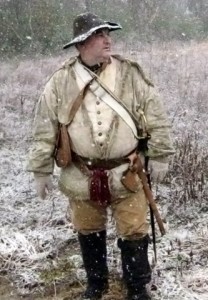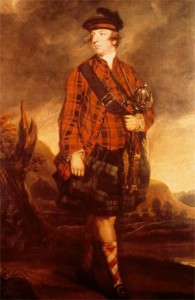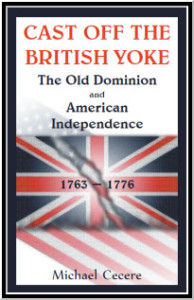 Relevant History welcomes Mike Cecere, who was raised in Maine but moved to Virginia in 1990, where he discovered a passion for American History. Mr. Cecere teaches U.S. History courses for Fairfax County Public Schools and Northern Virginia Community College. He was recognized by the Virginia Society of the Sons of the American Revolution as their 2005 Outstanding Teacher of the Year and is an avid Revolutionary War reenactor who lectures throughout the country on the American Revolution. Mr. Cecere is the author of eleven books on the American Revolution. His books focus primarily on the role that Virginians played in the Revolution. For more information, email him at umfspock87 [at] cs [dot] com.
Relevant History welcomes Mike Cecere, who was raised in Maine but moved to Virginia in 1990, where he discovered a passion for American History. Mr. Cecere teaches U.S. History courses for Fairfax County Public Schools and Northern Virginia Community College. He was recognized by the Virginia Society of the Sons of the American Revolution as their 2005 Outstanding Teacher of the Year and is an avid Revolutionary War reenactor who lectures throughout the country on the American Revolution. Mr. Cecere is the author of eleven books on the American Revolution. His books focus primarily on the role that Virginians played in the Revolution. For more information, email him at umfspock87 [at] cs [dot] com.
*****
The famous, “shot heard around the world,” fired on Lexington Green on 19 April 1775 is universally acknowledged as the starting point of the Revolutionary War and ultimately, American independence. The argument goes that an unstoppable force was unleashed when the Massachusetts militia challenged a British raid to seize gunpowder and arms in Concord. The bloodshed of Lexington and Concord propelled Britain and her American colonies into a full-blown war, a war that fifteen months later resulted in America’s Declaration of Independence.
More to the Story
What is overlooked by this view of the origins of the Revolutionary War is that for the colonies outside of New England, many months passed before blood was shed within their borders. It was far from a foregone conclusion after Lexington and Concord that the colonies outside of New England would participate in a war against Great Britain, much less declare independence from the mother county. The mid-Atlantic and southern colonies moved towards conflict with the mother country at their own pace, largely separated from the events unfolding in New England.
Hand on the Trigger
 Just two days after the bloodshed of Lexington and Concord, Virginia experienced its own crisis when its royal governor, Lord Dunmore, ordered a supply of gunpowder removed from the powder magazine in the center of Williamsburg to a British warship in the James River. A large, angry crowd gathered in Williamsburg and hundreds of militia from the surrounding countryside prepared to march on the capital to demand the powder’s return. Three weeks earlier, Patrick Henry, Virginia most famous orator and politician, had declared, “Give Me Liberty or Give Me Death” in an effort to strengthen Virginia’s militia. He had predicted war with Britain, and in late April and early May of 1775 it looked to many Virginians that Henry’s prediction had come true. More moderate voices, led by Peyton Randolph, the Speaker of the House of Burgesses, managed to defuse the crisis and disburse the militia, but tensions remained.
Just two days after the bloodshed of Lexington and Concord, Virginia experienced its own crisis when its royal governor, Lord Dunmore, ordered a supply of gunpowder removed from the powder magazine in the center of Williamsburg to a British warship in the James River. A large, angry crowd gathered in Williamsburg and hundreds of militia from the surrounding countryside prepared to march on the capital to demand the powder’s return. Three weeks earlier, Patrick Henry, Virginia most famous orator and politician, had declared, “Give Me Liberty or Give Me Death” in an effort to strengthen Virginia’s militia. He had predicted war with Britain, and in late April and early May of 1775 it looked to many Virginians that Henry’s prediction had come true. More moderate voices, led by Peyton Randolph, the Speaker of the House of Burgesses, managed to defuse the crisis and disburse the militia, but tensions remained.
While Virginia’s delegates to the Second Continental Congress supported a proposal in June to form a continental army and appoint a fellow Virginian, George Washington, to command it, the Virginia House of Burgesses pleaded with Governor Dunmore, who had fled to a British warship in early June, to return to the capital so the business of governing could resume. Weeks of stalemate passed in Virginia while in Massachusetts, the bloody battle of Bunker Hill occurred, and the British army in Boston was besieged by New England militia.
By the end of the summer, hundreds of militia had gathered in Williamsburg, and Virginia’s leaders had taken steps to significantly strengthen the colony’s military forces (with militia battalions and two regiments of full time “regular” troops), but blood had yet to be shed in the Old Dominion.
The Gloves Come Off
This finally changed six months after the battle of Lexington and Concord when a small squadron of ships under Captain Matthew Squire of the H.M.S. Otter sailed into the Hampton River in late October to burn Hampton. This was a retaliatory raid against the town, punishment for the destruction of a British tender that had washed ashore in a storm in September near Hampton and been destroyed by the townspeople. Captain Squire’s ships struggled to reach Hampton up the river channel, which was obstructed by the Virginians with sunken vessels. Heavy small-arms fire from the Virginians onshore drew a response from the British, and blood was shed on both sides. The British received the worst of it and reluctantly withdrew, sparing Hampton of destruction.
 Three weeks later in November, Lord Dunmore used a successful skirmish against the Princess Anne militia as a platform to raise the King’s standard and call on all loyal Virginians to rally to his, and the King’s, cause. Dunmore also offered freedom to any slave or indentured servant of a rebel who took up arms for him. Hundreds stepped forward to do so, and for a time it looked as if the royal governor just might re-establish royal authority in Virginia.
Three weeks later in November, Lord Dunmore used a successful skirmish against the Princess Anne militia as a platform to raise the King’s standard and call on all loyal Virginians to rally to his, and the King’s, cause. Dunmore also offered freedom to any slave or indentured servant of a rebel who took up arms for him. Hundreds stepped forward to do so, and for a time it looked as if the royal governor just might re-establish royal authority in Virginia.
Alas, Dunmore’s decisive defeat at the Battle of Great Bridge in early December was a turning point in his efforts to maintain control of southern Virginia. Forced to abandon Norfolk and seek shelter aboard ships in the Elizabeth River, Dunmore and his supporters spent the first six months of 1776 little more than refugees in Norfolk harbor.
It’s Gone Too Far
By the spring of 1776, Virginia’s movement towards independence from Great Britain appeared unstoppable, and calls echoed throughout the colony to “Cast off the British Yoke.” The Fifth Virginia Convention voted unanimously to do so on 15 May 1776, and instructions were sent to Virginia’s delegates in the Continental Congress to offer a resolution on independence on behalf of all the colonies. While debate on this proposal occurred in Philadelphia, the Fifth Virginia Convention drafted a new state constitution and a Declaration of Rights, adopting both before independence was formally voted on in Congress.
The path to American independence was far more complicated than is widely known. Virginia’s journey is a fascinating tale. The story of Virginia’s movement to independence is the focus of my new book, Cast Off the British Yoke: The Old Dominion and American Independence, 1763-1776. The book chronicles the key events that led to Virginia’s entry into the Revolutionary War in October 1775 and its eventual support for independence from Great Britain in the spring of 1776.
*****
**********
Did you like what you read? Learn about downloads, discounts, and special offers from Relevant History authors and Suzanne Adair. Subscribe to Suzanne’s free newsletter.

